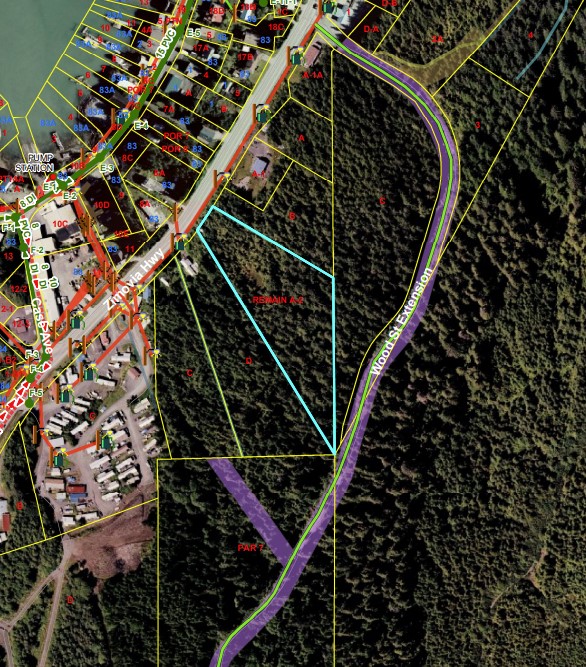
Current zoning at the Torgramsen-Glasner Subdivision, down Wrangell’s Zimovia Highway near the hospital, can be a bit confusing. It’s zoned single-family residential. A few commercial properties exist near the area though: a gas station, storage units and the Wrangell Cooperative Association.
Two developers, Phillip Mach and John Ester, want to rezone their 3.6 acre lot to light industrial. This change would accommodate another storage unit business they plan to open. They say their investment would help boost the city’s economy. It would provide boat and vehicle storage on top of a storage unit warehouse for rental. But some residents oppose this proposed development. Wrangell’s Borough Assembly is figuring out a way to be fair for all parties involved. But it might take rezoning the whole subdivision.
Contract zones
Borough Manager Mason Villarma said the petition to rezone was a contentious issue.
“There’s a lot of different factors at play,” Villarma said. “The reason for it being so contentious is the precedent that was set. And really what happened is there’s a contract zone that was created in our zoning code. And a contract zone basically gives the privilege of a different zoning criteria but the property still reverts back to its initial zone.”
He said a couple areas in the subdivision have different zonings and not all of them are true zonings. Several of them are contract zones, which means the owner of the specific parcel can follow different zoning codes. But contract zones do not transfer if the lots are sold.
Villarma said, “If I sell the property that has been contract zoned for light industrial, it’s gonna go revert back to its zone of origin, which had been single-family residential.”
Villarma said that the courts rarely honor contract zones because it resembles spot zoning. Spot zoning usually benefits the landowner while having detrimental effects to the neighboring parcel owners. This might open up the opportunity for discrimination, which is why the courts disfavor contract zoning.
“There seems like there’s some inequity,” Villarma said. “Then on the flip side of it you have a single-family residential owner who’s building a house that likely doesn’t want to see a sawmill next to him or whatever full on privileges of light industrial looks like and that’s understood, too.”
Because of that, the borough plans to eliminate any existing contract zones and the potential for future ones.
“It opens us up to liability,” Villarma said. “You’re essentially spot zoning or you’re opening yourself up to liability being accused of spot zoning. And it could potentially deviate from your comprehensive plan which this is generally done. Granted, our comprehensive plan needs to be updated and we’re pursuing that process.”
The borough last updated the comprehensive plan 12 years ago. Villarma said he would like to see consistency in the plan, which includes zoning.
“…it just backfires on the people surrounding it.”
Bruce Smith owns property adjacent to the proposed area for rezoning. He opposes the request to change the area from single-family residential to light industrial.
“An open light industrial zone to a residential area could lead to problems not necessarily with the current owner and his plan, but maybe with the future owners having different plans,” he said. “By changing the zone to a light industrial, you lose any controls and safeguards that a contract zone would provide to the neighboring residence.”
Terri Henson, the Chair of the Planning and Zoning Committee, said they considered rezoning the parcel to light industrial. She said that there seems to be a constant conflict between industrial and residential neighborhoods.
“In 23 years on Planning and Zoning, whenever you start to get overly mixed uses it just backfires on the people surrounding it,” she said.
The Planning Committee advised the borough assembly against rezoning the parcel.
“As Planning and Zoning Chairman, I’m gonna say I would really appreciate that you stand by what our decision was,” Henson said.
Rezoning the entire subdivision
The borough assembly discussed options that could be fair and equitable for all sides, which includes rezoning and creating necessary buffers between light industrial and residential, as well as considering the angles for lighting.
Borough Manager Villarma said they’re going to move forward with instructing the Planning and Zoning Committee on rezoning the whole area to a multi-use residential district. This would allow residential and light industrial zoning to coincide with each other.
“What we can’t do is we can’t just axe these contracts zones in its entirety and say tear down your storage units,” he said. “This is a single-family residential area, that’s not going to happen. So in fairness, I think we’ve inherited what we’ve inherited, like we have this multi-use area that’s not defined as such encode yet.”
Villarma said using what is already in the area as a guide, like Wrangell Cooperative Association’s transportation building, would help define what “light industrial” means in the subdivision. This would ensure that zoning wouldn’t expand in character past the commercial storage unit or transportation building. And there would be buffers, like a 25-foot vegetated zone that separates the properties.
Villarma said he hopes to get the rezoning issue before assembly in September. Then vote on it.
But the timeline is up in the air since Planning and Zoning still have to meet on rezoning all of the single-family residential subdivision to multi-use residential, instead of just the proposed parcel.












